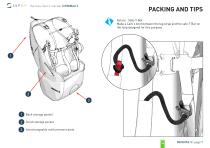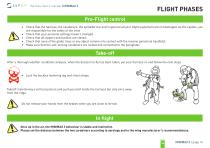
Catalog excerpts

User’s manual PARC ALTAÏS 34 RUE ADRASTÉE 74650 ANNECY CHAVANOD FRANCE RCS 387956790 Revision index : V1 20/05/202
Open the catalog to page 1
Harness User’s manual | MINIMAX 3 hank you for choosing the Minimax 3. We are glad to be able to share our common paragliding passion with you. SUPAIR has been designing, producing and selling free flying equipment since 1984. By choosing a SUPAIR product you benefit from almost thirty years of expertise, innovation and listening. This is also our philosophy : working endlessly to develop better products and to maintain a high quality production. We hope you will find this user’s manual comprehensive, explicit and hopefully enjoyable as well. We advise you to read it carefully. You will...
Open the catalog to page 2
Harness User’s manual | MINIMAX 3 Introduction 4 Technical specifications 5 Components list 6 Harness Overview 7 Accessories assembly 8 Seat plate 8 Carabiners8 Gear packing and tips 9 Adjustments 10 The various adjustments 10 Adjusting the harness 11 Wing/harness Connection 12 Inflight behavior 13 Flight phases 14 Pre-Flight check 14 Take-off 14 In flight 14 Landing 15 Towing 15 Mandatory controls 15 In case of an incident 16 Maintenance 17 Harness cleaning and maintenance 17 Storage and transport 17 Product longevity 17 LIST OF CONTENTS Repairs / spare parts Materials Recycling Warranty...
Open the catalog to page 3
Harness User’s manual | MINIMAX 3 Welcome to the world of paragliding according to SUPAIR, a world of shared passion. The MINIMAX 3 is a tandem harness passenger designed with an airbag protection. This harness is designed for intensive and professional use. The well though-out design and choice of materials were guided by the same quality and durability objectives. The MINIMAX 3 harness was certified EN 1651 : 2018 and LTF Nfl II 91/09. Indicating that it meets European and German safety requirements. After reading this manual, we suggest you to check your harness in static hang-posts to...
Open the catalog to page 4
Harness User’s manual | MINIMAX 3 TECHNICAL SPECIFICATIONS Harness size Pilot size (cm) Pilot weight (mini - maxi) (kg) Harness weight (+ carabiners+speedbar)(kg) Designed for Back lenght (cm) Backrest tilt adjustment (cm) Seat length (cm) Seat width (cm) Carabiners height (cm) Carabiners distance (cm) Impact damping system Certification Tandem (Pilot or Passenger) Towing Quick-out carabiners compatibility Reserve parachute pocket volume (litre) Back lenght Backrest tilt adjustment Seat width Carabiners height Seat length Carabiners distance
Open the catalog to page 5
Harness User’s manual | MINIMAX 3 2x 45 mm Zicral self-locking carabiners 2 x Mylar AIRBAG ( MYABMA ) Polypropylene seat plate Options Carbon seat plate (ref. :seat plate L: 37*37cm : MPPL007) Mylar airbag MYABMA ( ref: PROMYABMA) Standard rigid spreader bars (réf. :ECABISTD2 )
Open the catalog to page 6
Harness User’s manual | MINIMAX 3 HARNESS OVERVIEW Backrest angle adjustment Shoulder strap adjustment Paragliding main hooking points Small storage pocket 10 Back storage pocket Chest strap adjustment Chest strap with automatic buckles Velcro Opening for changing the Mylar
Open the catalog to page 7
Harness User’s manual | MINIMAX 3 ACCESSORIES ASSEMBLY Carabiners Compatible carabiners : 45 mm Self-locking zicral carabiners Réf. : MAILCOMOUS45 Seat plate Polypropylene seat plate : Size L Réf. : MPPL032 Insert the carabiner through the main harness riser connection. 1. Turn over the seat 2. Slide the plate under the seat, being careful to put the leg straps behind the plate Flight direction
Open the catalog to page 8
Harness User’s manual | MINIMAX 3 PACKING AND TIPS Astuce : Safe-T-Bar Make a Lark’s knot between the leg strap and the safe-T Bar on the loop designed for this purpose. 1 Back storage pocket 2 Small storage pocket 3 Interchangeable reinforcement plate
Open the catalog to page 9
Harness User’s manual | MINIMAX 3 Adjusting the harness prior each takeoff is vital. Adjusting the chest strap Adjusting the shoulder straps
Open the catalog to page 10
Harness User’s manual | MINIMAX 3 ADJUSTING THE HARNESS Adjusting the harness Without strap tension, first adjust the backrest incline at the desired angle. - Tightening will bring the backrest at a more vertical angle ( recommended posture for beginners ). - Loosening the backrest will tilt the back support rearward. Adjusting the chest strap : The distance to consider corresponds to the length between the middle points at the bottom of each carabiner. The ideal distance varies between paragliding wing models. Adjust your harness’s chest strap according to the wing manufacturer’s...
Open the catalog to page 11
Harness User’s manual | MINIMAX 3 CONNECTING THE WING TO THE HARNESS Connecting the wing to the spreader bars Connect the Minimax 3 to the spreader bars on the loop meant for that purpose Flight direction Flight direction
Open the catalog to page 12
Harness User’s manual | MINIMAX 3 FLIGHT BEHAVIOR The Minimax 3 is a stable and comfortable tandem harness passenger, with an easy transition between seated and stand-up position The Minimax 3 harness has been designed for professional tandem pilots as well as leisure pilots To learn more about this harness, we advise you to carry out the first flights with it in stable conditions, preferably flying on-site or in an area that you are familiar with.
Open the catalog to page 13
Harness User’s manual | MINIMAX 3 FLIGHT PHASES Pre-Flight control • Check that the harness, the carabiners, the spreader bar and in general all your flight equipment are not damaged. As the captain, you are responsible for the safety of the crew • Check that your personal settings haven’t changed. • Check that all zippers and buckles are closed. • Check that none of the glider lines or any object comme into contact with the reserve parachute handle(s). • Make sure that the self-locking carabiners are locked and connected to the paraglider. Take-off After a thorough weather conditions...
Open the catalog to page 14
Harness User’s manual | MINIMAX 3 FLIGHT PHASES Landing Straighten yourself in your harness and adopt a running posture to dissipate the horizontal speed. Always be certain to have enough altitude to make a landing approach corresponding to the weather conditions of the moment and terrain. During the landing approach, never make hasty maneuvers. Always land upwind in a standing posture and be ready to run upon touchdown if necessary. During your final approach, use as much airspeed as possible based on the weather conditions of the moment, then gradually reduce the glider air speed by...
Open the catalog to page 15All SupAir-VLD catalogs and technical brochures
-
RADICAL 3
30 Pages
-
VIP LITE
14 Pages
-
EVEREST3
18 Pages
-
MINIMAX BUMP
17 Pages
-
EVO LITE
39 Pages
-
DELIGHT 3
31 Pages
-
SKYPPER 2
37 Pages
-
ACRO 4
34 Pages
-
ALTIRANDO LITE
33 Pages
-
PIXAIR 2
35 Pages
-
ACCESS 2 BUMP
38 Pages
-
ACCESS 2 AIRBAG
37 Pages
-
WALIBI 3
38 Pages
-
STRIKE 2
40 Pages
-
KINDER 2
20 Pages
-
LOUSTIC 2
20 Pages
-
FLUID
30 Pages
-
START
15 Pages
-
SHINE
22 Pages
-
STEP
36 Pages
-
LEAF 2
36 Pages
-
LEAF 2 LIGHT
32 Pages
-
SAVAGE
30 Pages
-
STEP light
29 Pages
-
SORA 2 PLUS
28 Pages
-
EONA 3
36 Pages
-
CATALOGUE SUPAIR 2017 2018
39 Pages





























